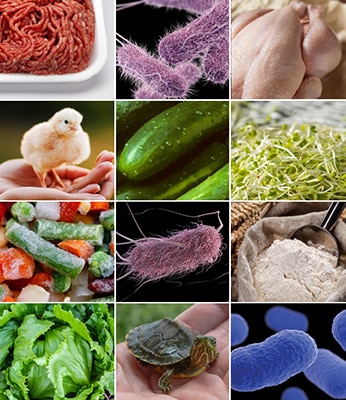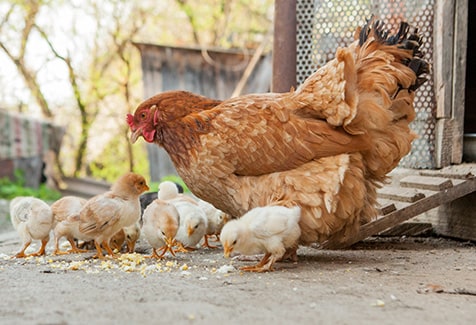Summary of Possible Multistate Enteric (Intestinal) Disease Outbreaks in 2016
CDC’s Investigations of Possible Multistate Outbreaks Caused by Salmonella, Shiga toxin-producing E. coli, and Listeria monocytogenes
CDC’s Investigations of Possible Multistate Outbreaks Caused by Salmonella, Shiga toxin-producing E. coli, and Listeria monocytogenes, 2016

Read the MMWR and see the data visualized in charts [PDF – 56 pages] to learn about:
- Our investigation process
- Results of our investigations, including who became sick and the foods and animals that were identified as sources of outbreaks
- Our public health communication efforts and reach
Going forward, we will post summaries of multistate outbreak investigations linked to food or animal contact on this page as they become available.
- In 2016, CDC investigated 118 possible multistate outbreaks, of which 50 were determined to be outbreaks. Of these, outbreak investigators identified a suspected source for 11 outbreaks and confirmed a source for 28 outbreaks.
- Multistate outbreaks linked to animal contact (1,077 illnesses) caused more known illnesses than multistate outbreaks linked to contaminated food (656 illnesses).
- Among multistate foodborne outbreaks, chicken was the source of the most illnesses while sprouts were the most frequent source of outbreaks. Among animal contact outbreaks, backyard poultry was the source of most illnesses and outbreaks.
- CDC notified the public about 11 multistate foodborne outbreaks and 9 multistate animal contact outbreaks. Outbreaks linked to new food sources drew the most attention on CDC’s website and social media: E. coli in flour, Listeria in frozen vegetables, and Listeria in packaged salad.
- Though challenging and resource intensive, multistate outbreak investigations are frequently needed and critical in identifying outbreak sources and gaps in the food safety system.

Why was the outbreak important?
This was the first time an E. coli outbreak was definitively linked to flour. Although investigators suspected that contaminated flour was the source of a 2009 outbreak linked to cookie dough and a 2016 outbreak linked to pizza dough, they did not have enough evidence to confirm it.
What happened as a result of this outbreak?
This outbreak helped raise awareness that raw dough, raw batter, and other foods made with raw flour should not be eaten before cooking – even if just tasting. Flour producers are researching ways to reduce risk of contamination.

Why was the outbreak important?
This was the first time a Listeria outbreak was linked to frozen produce. Frozen produce was not considered to be ready-to-eat, meaning that consumers are expected to cook them to kill any germs that might be present, including Listeria. However, many people do not know this.
What happened as a result of this outbreak?
A very large amount of food was recalled – 456 frozen fruit and vegetable products sold under 42 brand names and another 47 million pounds of meat and chicken products containing frozen produce. In addition, U.S. Department of Agriculture (USDA) funded a study to learn more about how people handle and prepare frozen vegetables.

Why was the outbreak important?
This was the first Listeria outbreak linked to packaged salads, which have typically been linked to other foodborne pathogens, such as E. coli and Salmonella.
What happened as a result of this outbreak?
The packaged salad producer recalled all products made at the facility where the outbreak strain was identified. This recall cost the company $25.5 million, plus another $85 million in lost revenue. Industry and academic partners are funding research on preventing Listeria contamination in facilities that process leafy greens.

Why were these outbreaks important?
Sprouts caused the most foodborne outbreaks and the second-highest number of outbreak-related illnesses in 2016. These outbreaks emphasized the importance of U.S. Food and Drug Administration (FDA) regulatory measures to improve sprout safety. FDA’s Produce Safety Rule took effect in January 2016 and requires sprout producers to treat seeds to reduce germs and test the water used to sprout seeds.
What happened after these outbreaks?
CDC is working to analyze data on outbreaks linked to sprouts and is evaluating what more can be done to prevent illnesses. FDA issued draft guidance to help sprout operations comply with the new regulations in 2017.

Why was the outbreak important?
More illnesses were linked to contact with live poultry in 2016 than in any previous year. Poultry came from multiple hatcheries, suggesting opportunities for prevention within the backyard poultry industry.
What happened as a result of this outbreak?
CDC continued to strengthen partnerships with the backyard poultry industry to reduce Salmonella in poultry and to encourage sharing information with backyard flock owners on how to stay safe around their birds. Several businesses and hatcheries use CDC flyers on poultry shipping boxes and distribute them with every poultry purchase.

Why was the outbreak important?
The sale of tiny turtles (shells less than 4 inches in length) for pets was banned in the United States in the 1970s because they were linked to Salmonella illnesses. However, outbreaks linked to the reptiles continue. This outbreak highlighted the risk of small pet turtles spreading Salmonella and the need for reptile owners to take steps to stay safe around their pets.
What happened as a result of this outbreak?
CDC alerted the World Health Organization (WHO) about the outbreak and the risk of Salmonella infection from pet turtles exported from the United States to other countries. WHO posted a Disease Outbreak News notice to inform the international health community about the investigation, risks associated with small pet turtles, and the need for education.
CDC’s Role in Multistate Enteric Disease Outbreak Investigations
CDC helps enable rapid and coordinated responses to multistate outbreaks and works closely with state and local health officials, the U.S. Food and Drug Administration (FDA), and the U.S. Department of Agriculture (USDA) Food Safety and Inspection Service (FSIS) and Animal and Plant Health Inspection Service (APHIS).
Read more about CDC’s role in investigating multistate outbreaks.
CDC’s Multistate Outbreak Investigation Process
CDC typically coordinates between 17 and 36 investigations of possible multistate foodborne and animal contact illness outbreaks each week. These outbreaks are usually detected by PulseNet, CDC’s national laboratory network for detecting enteric (intestinal) disease outbreaks. PulseNet compares the DNA fingerprints of bacteria from sick people.
When multiple people get sick around the same time from bacteria with the same fingerprint, that indicates a possible outbreak. Local and state health officials interview sick people and share that information with CDC. A possible outbreak is determined to be an outbreak if public health officials find something in common linking the illnesses to each other, such as eating the same food, eating at the same restaurant, shopping at the same grocery store, or attending the same event.
Read more about steps in CDC’s investigation process and active outbreaks that CDC is investigating.
CDC’s Enteric Disease Surveillance and Reports
CDC uses several surveillance systems to track and monitor reports of enteric diseases in the United States. These systems help us detect and prevent disease and outbreaks.
Read more about CDC’s enteric disease surveillance and data systems and annual reports on foodborne outbreaks and animal contact outbreaks.
CDC’s Public Communication Process
CDC follows a consistent process for communicating with the public about ongoing multistate enteric disease outbreaks.
For foodborne outbreaks, CDC is most likely to warn the public when the investigation identifies a specific food linked to illness, and there is a continuing risk to the public because the food is still in stores, restaurants, or homes. CDC announces the outbreak using either a Food Safety Alert (the food has been identified) or an Investigation Notice (specific food information not available) to tell people what they can do to protect their health.
For outbreaks linked to animal contact, CDC is most likely to warn the public when the investigation identifies a specific animal. CDC announces the outbreak using an Investigation Notice to provide advice to pet owners, retailers, and breeders on steps they can take to prevent getting sick around the animals.
Read more about CDC’s public communication process.